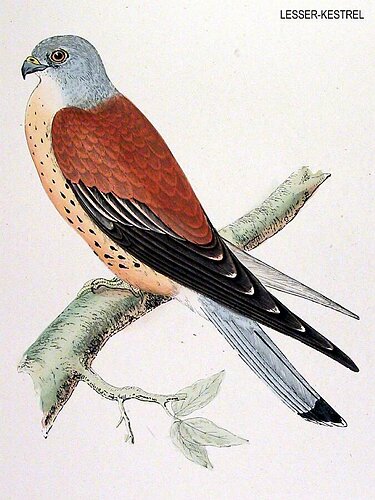LESSER KESTREL.
Falco tinnunculoides, NATTERER. TEMMINCK. Falco cenchris, NAUMANN.
SCHLEGEL. Falco tinnuncularis, VIEILLOT. Falco gracilis, LESSON.
Cerchneis cenchris, BUONAPARTE.
Falco—To cut with a bill or hook. Tinnunculoides—Like
a Tinnunculus or Kestrel.
Since the death of my friend the late Mr. Arthur Strickland,
of Bridlington Quay, who knew more about birds, both British and foreign,
than any one else I have ever met, and who was also wonderfully well
acquainted with natural history generally, and with many other subjects
of interest in art and science, there is no one whose authority stands
higher, I should suppose, than Professor Alfred Newton, of the University
of Cambridge. His opinion as to the claims of the above-named bird
as British, when I met him at the Meeting of the British Association
in Exeter, last year, and took the opportunity of consulting him as
to the admission of several supposed new species for the present new
edition of this work, all the former issues having been merely reprints,
was against it. But as his opinion was entirely based on a doubt as
to one of the matters of fact, where I had none, I felt bound, though
unwilling I can assure the worthy and learned professor, to differ
from him, to give the bird the benefit of my having no doubt on that
part of the question, and to insert the following account of it in
these pages.
I am indebted to the excellent work of C. R. Bree, Esq., M.D., for
the particulars of its natural history. It inhabits chiefly the eastern
and southern parts of Europe, being found more or less commonly in
Italy, Hungary, Austria, Greece, Sicily, France, chiefly in Languedoc
and Provence, Spain, and Switzerland. In Asia in the Crimea; in Africa
also.
The following is the account of its occurrence as a British bird,
as given by Mr. W. S. Dallas, F.L.S., then Curator of the Museum of
the Yorkshire Philosophical Society, forwarded to me by my friend
the Rev. Charles Hudson, Rector of Trowell, Nottinghamshire, the owner
of one of the specimens, both of which, as will be observed,occurred
in Yorkshire :—'This museum has just been fortunate enough to
obtain a fine specimen, killed within a few miles of York, of a species
of Falcon, the occurrence of which in this country has, I believe,
never before been authentically recorded, namely, the Little Kestrel
of South-eastern Europe (Tinnuncidus cenchris, Naum.): the specimen,
which is a mature, but apparently not an old, male, was presented
to the museum by Mr. John Harrison, of Wilsthorpe Hall, near Green
Hammerton, who shot it upon his farm at that place, after having observed
it for some little time flying about.
The date, he thinks, was about the middle of last November; but of
this he took no note, as he at first thought that the bird was merely
a small and curious variety of the Common Kestrel. It, however, presents
all the distinctive characters of Tinnunculus cenchris, among which
the yellowish white claws may be mentioned as affording an easy means
of identifying the bird.
Mr. David Graham, of York, to whose intervention the museum is indebted
for the acquisition of this interesting specimen, has informed me
that, on a recent excursion of his, he saw another example of this
species in the possession of the above-named Mr. Hudson. On my writing
to that gentleman, he kindly informed me that the specimen of the
'Small Kestrel' had been in his possession for about eight years,
and that he purchased it from a joiner named Brown, formerly living
at Thorpe Hall, near Bridlington, who was an enthusiastic collector
of birds, and in the habit of preparing them for the people in that
neighbourhood. Brown's account of the bird, which he denominated the
'American Falcon,' was that it was shot between Bridlington and Bridlington
Quay, by a man who sold it to him for eighteen pence. Mr. Hudson purchased
it for half a sovereign.'
The Lesser Kestrel feeds on insects, beetles, grasshoppers, etc.,
as also on small reptiles, and, though but rarely, on small birds.
It builds among old ruins, or in the crevices of mountain rocks.
The eggs are said to be three or four in number, of a reddish white
ground-colour, with a great number of little points and spots of a
brick-dust red, commingled together and mixed with other small brown
spots. There are several varieties of them.
The following are the 'propria quae maribus :'—Bill, bluish;
cere, yellow; eyelids, yellow; head on the crown and sides, as also
the nape, of a light ash-colour without spots; throat, lighter coloured;
breast, of a clear reddish russet, studded with small spots and streaks
lengthwise of black; back, dark brick-red, unspotted. The wings reach
to the end of the tail; greater wing coverts, dark brick-red, but
some of them bluish ash-colour; secondaries, bluish ash. - Tail, bluish
ash-colour, with a large black band at the end, which is tipped with
white; upper tail coverts, bluish ash-colour; claws, yellow.
The female is like the female of the Common Kestrel. The young at
first much resemble her in plumage.
" A Falcon hovered on her nest, With wings outspread and forward
breast."
Marmion.
